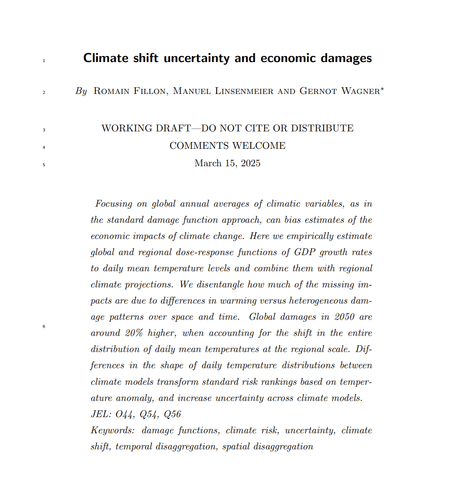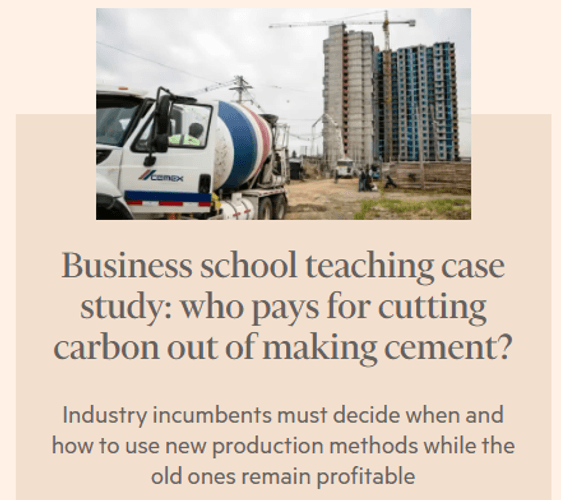Whale blubber and horse manure
Excerpt from Chapter 6, "Mind versus Matter," from: But will the planet notice? How smart economics can save the world (Hill & Wang/Farrar Strauss & Giroux, 2011; paperback, 2012), for use in: Climate Policy—Past, Present, and Future (Fall 2016).
We are running out of oil. That’s a simple physical reality. The entire climate problem is a matter of simple arithmetic. Every day we extract carbon that took thousands of years to put underground, and we pump it into the air.[i] It’s easy to see why the age of fossil fuels will have to come to an end. We simply cannot go on extracting oil at the rate we are doing now. The only question, really, is whether we will run out of oil, coal, and gas before we run out of atmosphere. Unfortunately, in a manner of modeling, the answer is no. If we ran out of fossil fuels tomorrow, climate instability wouldn’t be the problem it is without that hard stop. We’d naturally transition out of fossil fuels into a greener, cleaner alternative, or at least into one producing fewer heat-trapping gases.
We have seen that game play out before. If you listen to the technological optimists, they usually tell two stories with similar endings but rather unrelated protagonists: whale oil and horse manure.
I first heard about both listening to Martin Weitzman during his introductory economics class. In typical economist fashion, he looked to these stories as examples of how technological progress tends to save the day in the direst of moments. We face problems, real problems, often with consequences more dire than the whale oil and horse manure examples would lead us to believe. But they are very instructive in their own right.
For once, Weitzman may not have gotten the full story right. Yes, technological progress is powerful beyond belief and we ignore its power at our peril. Weitzman has made convincing, math-heavy arguments in support of this point.[ii] But there’s another twist here: technological progress doesn’t happen all by itself. We sometimes trumpet technological progress too loudly without looking at the deeper forces that lead us to start innovating in the first place. Once again we are back at setting the right goalposts, at putting the right incentives in place.
Throughout most of human history, the day started at dawn and ended at dusk. Reading at night was a fickle, smelly, and often eye-ruining experience, which was particularly unfortunate because ophthalmology wasn’t all that advanced either.
The middle of the eighteenth century saw the invention “of a new kind of Candles very convenient to read by,” as Benjamin Franklin wrote in a letter in the dark of winter in 1751: “They afford a clear white Light…their Drops do not make Grease Spots like those from common Candles.”[iii] He likely referred to candles made from spermaceti, a fat found in the head of sperm whales. Those candles were a step up from wax derived from the blubber of the right whale, named that way for no other reason than that for a long time it was the right whale to harpoon at sea. And harpoon we did, to the point where whaling turned into a global hunt for every remaining right and sperm whale slow and unfortunate enough to be caught with the technologies available to nineteenth century whaling fleets.
Sound familiar? It should. Just substitute bluefin tuna, cod, salmon, and sea bass and bring the story forward a century. Repeating history, however, is usually the signal flare to study it all the more closely.
Whale oil production peaked sometime in the mid-1800s. That coincides roughly with the discovery of “rock oil,” the literal English translation of petroleum. One conclusion: innovation saves the day yet again. “Greenpeace should have a picture of John D. Rockefeller on the wall of every office,” says Matt Ridley, the Rational Optimist, citing Warren Meyer, an irrational climate denier. And indeed, it looks that way at first blush.
It takes a particular kind of obsessive compulsive to set out to discover the true story. Italian chemist Ugo Bardi did just that and sifted through a sea of whale oil production and pricing data. He came up with a surprising result. Whale oil production hit its peak before 1850 and began a steep decline in the subsequent decade, cresting and falling well before the first rock oil from Titusville, Pennsylvania became available in 1859. Whale oil production was at less than half its pre-1850 peak when kerosene started to become commonly available. (Kerosene would soon be replaced by electricity as the light source of choice, although that took another few decades. Thomas Edison made his first announcements about the incandescent lightbulb in 1879.) Bardi concludes that,
the peaking and the initial phase of decline of whale oil production were not caused by the availability of a better technology, but by the physical depletion of the resource.[iv]
Whale oil production went down because whales were increasingly harder to find.
A look at the size of the whaling fleet confirms the real story. Whale oil production declined about a decade before the size of the fleet peaked. In short, whalers weren’t cutting back on their efforts. They were out in force with their harpoons, just not having much luck finding many suitable targets left.
Indeed, if there was a single event beyond resource depletion that saved the whales, it would have been the U.S. Civil War, which started in 1861 and prompted Union whalers to keep their ships in port lest they risk getting captured by Confederate raiders. By the time Union troops emerged as the victor in 1865, kerosene had made sufficient market inroads to make renewed whaling efforts not worth the investment. The boats that did venture out found fewer and fewer whales. The seas had been largely emptied of them save some treacherous and frigid Arctic territories. Steamboats offered renewed hope for whalers, but by then it was too late. Kerosene and later electricity had replaced whale oil as the luminescence of choice.
The parallel—or rather missing parallel—to our current situation is striking: it is as if we were transitioning away from oil, coal, and gas because they are increasingly harder to find. That may be true to some extent for some oil fields that are past their prime, but there is still plenty of oil underground that, when pumped into the atmosphere, would wreak tremendous havoc. And what goes for oil goes for coal and gas even more so. We have tremendous deposits of both still waiting to be tapped.
Oil provided the impetus for another revolution. While whales were declining, horses multiplied—not out in the wide open plains but right in the heart of major cities. Horses had been the most important mode of transportation for thousands of years. It wasn’t until the late 1800s that they really took off. New Yorkers made over 30 million trips on horse-drawn carriages in 1860. By the end of the decade, that figure topped 100 million, and there was no end in sight. In the 1890s, 200,000 horses produced 2,500 tons of manure a day. It took thousands of horses just to haul the manure away. Much of it was simply dumped into empty lots. One doomsday scribe infamously predicted that by 1930 horse manure would blanket Manhattan three stories deep. In 1898, the world’s first urban planning conference broke up in disarray after only three of ten scheduled days. Delegates could not see a way out of the gridlock and stink. Mobility was as essential and addictive back then as it is today. It was a transportation, environmental, and public health nightmare rolled into one. The model of cities looked wholly unsustainable.
We know what came next. John D. Rockefeller, Henry Ford and others saved the day with oil-powered cars that pushed horse-drawn carriages out of New York.[v] In 1900, cars were still a luxury turning heads. That year 4,192 cars sold in the entire United States. By 1912, sales topped 350,000, and cars for the first time outnumbered horse-drawn carriages in New York City. Five years later, the last horse-drawn streetcar was retired for good and by the 1920s, horses were all but gone from city streets save for horse carriages shuttling tourists through Central Park and the occasional mounted cops, who to this day roam through Times Square and Central Park and look considerably more stately than their unfortunate colleagues on Segways.
The advent of cars was an awesome transformation of society and arguably only paled in impact by the speed of the spread of the Internet. While we would like to think that free-market capitalists, when they weren’t racing heartwarmingly undersized horses named Seabiscuit, presided over the rise of the car without any assistance, the fact is that anti-competitive and anti-capitalist behavior played a decisive role.
A heavy dose of government policy helped the rise of the car all along the way: from the building of interstate highways to Navy ships patrolling the Persian Gulf and even more direct subsidies for oil drilling. When General Motors bought up streetcars and converted them into buses through a wholly owned subsidiary, it effectively destroyed mass transit in over forty cities throughout the United States between the 1930s and 50s.[vi]
As always, incentives played a key role, and they were manipulated by a host of actors to favor the car. Detroit, as well as Saudi Arabia, knew full well what it meant to get Americans hooked on affordable cars and cheap gas. Why let a functioning rail system get in the way if you can help it? If it means that trains running between Chicago and New York actually take longer now than they did a century ago, so be it.
We cannot sit around and hope for the next grand technological breakthrough to rescue us all. We’ll keep inventing better, faster, and cheaper stuff. No doubt about it. We could even have government-directed research that may lead to some of these breakthroughs. It worked for the Internet. Why wouldn’t it here?
For starters, the Internet grew into a void. No one knew what to expect. We know exactly what we will have to achieve in the clean energy revolution. Governments and corporations have been nudging our grandparents, parents and us into cars. The overwhelming odds are, someone is going to have to nudge us out of them. Which brings up another irritating truth about energy: it’s so not cool.
People literally wait in line overnight to get the latest iPhone, or virtually iAnything. No one, however, waits for clean electrons, and far too few will choose to pay premiums for them. Apple’s ingenious branding department would be at a complete loss if it came to selling a steady stream of clean electrons. That points to a big fallacy in the way we think about new energy technology in general. When we think “innovation,” we think iPhone. We don’t think boring old commodities that have turned into everyday staples.
Clean electrons deliver little additional benefits to me that I couldn’t get from electrons piped in from a dirty old coal plant. There’s certainly no fun factor attached. Yes, there are some pluses to cleaner air, but the key benefit of lower carbon pollution doesn’t matter to me personally.
Repeat after me: My actions are less than a drop in a bucket and my making a personal sacrifice won’t make the atmosphere notice or appreciative. Unless ubiquitous clean energy becomes very cheap very soon, dirty energy needs to become more expensive to enable the transition.
References
[i] In “Burning buried sunshine: human consumption of ancient solar energy” (Climate Change, 2003), Jeffrey Dukes calculates that every gallon of gasoline “required approximately 90 metric tons of ancient plant matter as precursor material,” making it one of the more inefficient fuels: “the formation of oil and gas from phytoplankton is less than 0.01% efficient.” (By contrast, current solar panels achieve approximately 15% efficiency.) William Broad provides a short, comprehensive account of the formation of oil in “Tracing oil reserves to their tiny origins” (New York Times, August 3, 2010).
[ii] See Martin Weitzman’s Recombinant growth (1998).
[iii] Jane Brox’s Brilliant (2010) recounts this tale as part of the evolution of artificial light.
[iv] Ugo Bardi details whale oil extraction and prices in “Prices and Production over a complete Hubbert Cycle: the Case of the American Whale Fisheries in 19th Century” (Association for the Study of Peak Oil and Gas, November 24, 2004), largely based on numbers collected by Alexander Starbuck in his self-published History of the American Whale Fishery from its earliest inception to the year 1876 (Waltham, Massachusetts, 1878). Jane Brox retells the story in Brilliant: The evolution of artificial light (Houghton Mifflin Harcourt 2010). Bardi and Alessandro Lavacchi show data on whale oil and the size of the fleet (“A Simple Interpretation of Hubbert’s Model of Resource Exploitation,” Energies 2009). Note that the label in Figure 5 of that paper should read “year 0 = 1818,” not “1804,” a typo confirmed with the authors.
[v] The horse manure story has been told many times, most comprehensively by Eric Morris under the heading “From horse power to horsepower” (Access, 2007), most prominently by Steven Levitt and Stephen Dubner in Superfreakonomics (2009), and most convincingly by Elizabeth Kolbert in a New Yorker review of the book’s climate section (“Hosed,” November 16, 2009). Kolbert thankfully also clears up some of the misconceptions propagated by Superfreakonomics.
[vi] See The Automobile Age by James Flink (MIT Press, 1988) and The Decline of Transit by Glenn Yago (Cambridge, 1984).


